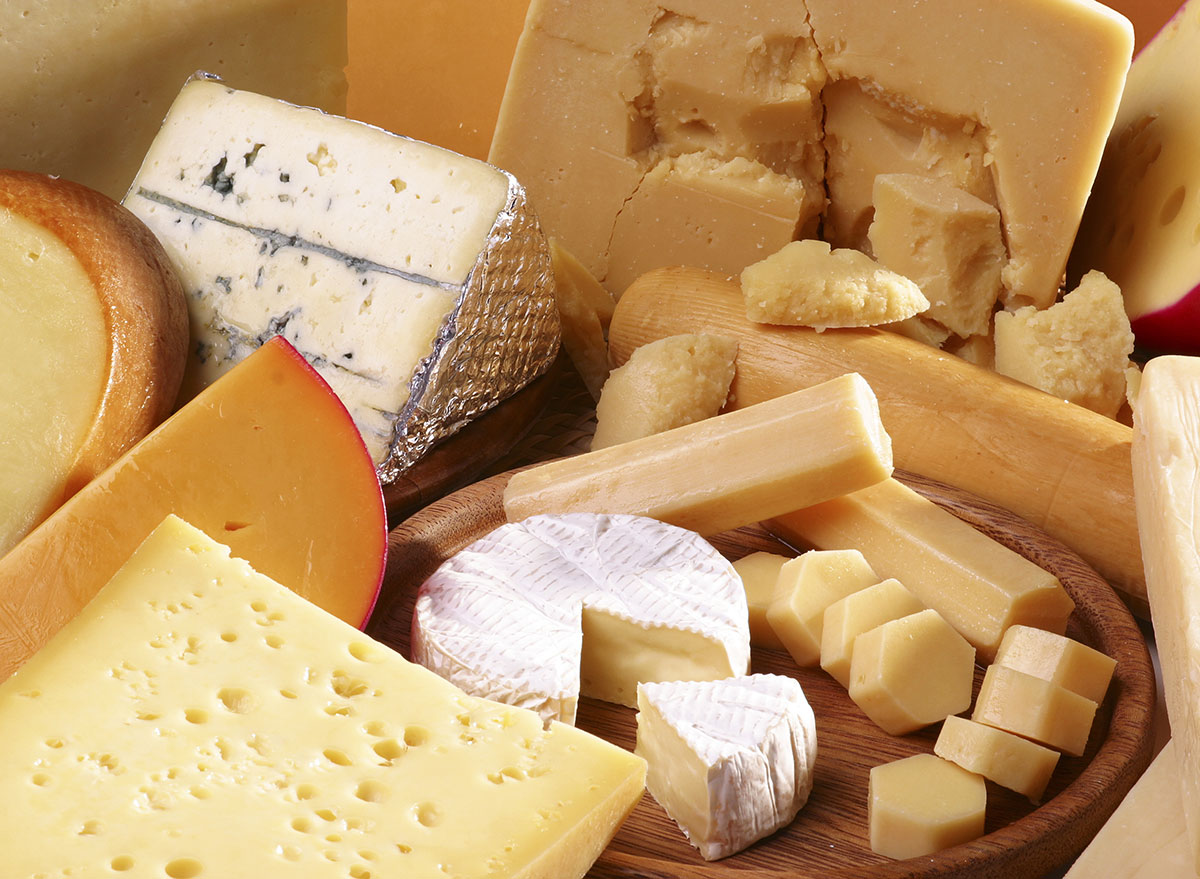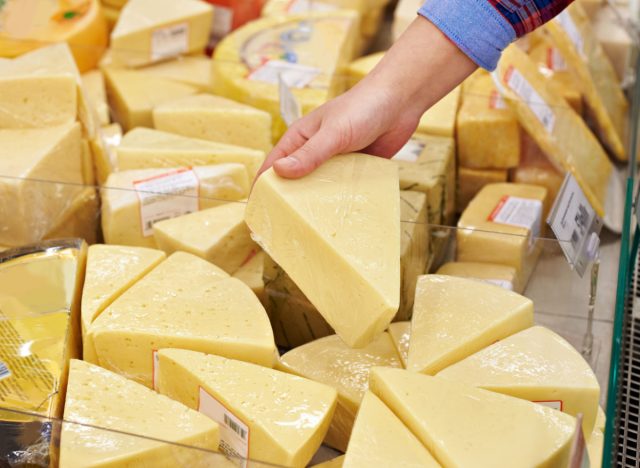Here's What Happens to Your Body If You Eat Cheese Every Day

Cheese is a popular milk-based food that can be enjoyed on its own or used as a delicious ingredient in meals and snacks, from cheddar in morning omelets to provolone on a lunch sandwich, cherry tomatoes with mozzarella balls as a Mediterranean-inspired snack, and parmesan with a farfalle pasta dinner. Die-hard cheese lovers may find themselves drawn to this tasty dairy food often, which may lead someone to wonder about the potential effects of eating cheese every day.
In addition to enhancing the flavor and texture of your favorite foods, cheese is also nutrient-rich. It's a good source of high-quality protein and calcium, in addition to providing many other nutrients and bioactive compounds, like magnesium and vitamin B12. On the other hand, cheese also adds a significant amount of sodium, saturated fat, and calories to your daily diet. There is also a lot of misinformation about cheese on the internet, which may make you wary of eating it. It's often called out as a major source of saturated fat, hard to digest, and blamed for everything from skin breakouts to diabetes.
To help set the record straight, here is what happens to your body if you eat cheese every day. Also, for more healthy eating tips about this dairy-based delight, be sure to check out 5 Cheeses You Can Still Eat if You Have High Cholesterol, Say Dietitians.
You'll up the calcium in your diet

According to the Dietary Guidelines for Americans, 30% of men and 60% of women don't get enough calcium in their diets, and 75% of us don't meet the daily dairy recommendations of three services per day or 1,000 mg calcium per day. Calcium helps to maintain healthy bones, but research also shows that it may help prevent types of cancer, may lower blood pressure, help prevent preeclampsia, and may help you maintain a healthy weight, according to a review conducted by the National Institutes of Health (NIH).
A 1.5-ounce serving of cheese provides anywhere from 115–350 milligrams of calcium, depending upon the variety, according to the Dietary Guidelines. In the United States, approximately 72% of calcium intakes come from dairy products and foods with added dairy ingredients, says NIH. Hard cheeses have the most calcium due to their lower water content, making them more nutrient-dense. Also, a 1.5-ounce serving of cheddar packs in 305 milligrams of calcium, or one-third of what an average adult needs in a day.
It may disagree with your stomach

According to the NIH, some 68% of the world's population suffers from some type of lactose malabsorption, which occurs when the body can't fully digest lactose, the main carbohydrate present in milk and dairy foods. If you are lactose-intolerant, cheese may cause stomach upset after eating it and lead to bloating, gas, and diarrhea.
The good news is that cheese is significantly lower in lactose than milk and yogurt. Hard, aged cheeses are the lowest in lactose and are generally well tolerated in small amounts. The cheeses that are the lowest in lactose and are generally well tolerated include Parmesan, Swiss, blue cheese, gouda, cheddar, brie, camembert, and Edam. Cheeses with the highest amounts of lactose include ricotta and cream cheese.
You'll likely improve your gut's microbiome
You probably know that yogurt with live, active cultures are one of the best ways to stock up on beneficial bacteria that help improve your microbiome and GI and immune system health, but many varieties of soft and hard cheeses, including cheddar, Edam, feta, Parmesan, Swiss, provolone, gouda, and gruyere, provide probiotics. Probiotics are found primarily in aged cheeses that are not pasteurized. Some cheesemakers are even adding probiotics to their cheese. For example, Babybel Plus+ Probiotic reportedly has one billion live and active cultures per serving.
Research is still in progress to better understand the quantity and viability of bacteria survival during cheesemaking, but to date, one study published in the Journal of Functional Foods explains how cheese can survive digestion and colonize in the GI tract to impart health benefits.
It may lower your risk for heart disease

While full-fat cheese is a significant source of saturated fat, you'd think it may increase your risk for coronary artery disease, but research suggests the opposite. One study reported in the Lancet, which included 135,000 participants in 21 countries, found no correlation between dairy food intake, including cheese, and risk for heart disease or major coronary events. In fact, the study reported that those who reported eating more than a serving of full-fat or low-fat dairy foods per day had reduced risk for heart disease, heart attack, or death from heart disease.
Another study reported in the European Journal of Nutrition compiled data from 15 large, population-based studies with more than 200,000 subjects in total. Their results also reported an inverse relationship between cheese consumption and cardiovascular disease. Those who ate cheese frequently were up to 18% less likely to develop cardiovascular disease, up to 14% less likely to develop coronary heart disease, and up to 10% less likely to have a stroke compared with those who had no or low cheese intake. The authors suggest that 1.4 ounces of cheese per day may be optimal for heart health benefits.
It may help your muscles recover after exercise
Endurance and strength athletes often rely on protein supplements to promote muscle recovery and provide strength and endurance gains. Milk is a high-quality protein with all nine essential amino acids. Research confirms that whey and casein proteins in milk can enhance recovery after exercise and help stimulate muscle protein synthesis. Cheese is primarily comprised of casein, a slow-to-digest protein that also promotes protein synthesis post-exercise. Whey is a fast-acting protein that is commonly taken immediately after exhaustive exercise, while casein is typically recommended to have before bedtime.
A recent study reported in the Journal of Nutrition found that among 20 healthy male strength athletes reported that 30 grams of protein from cheese enhanced muscle protein synthesis, the same as taking 30 grams of protein from milk. If you're active and want to help your muscles recover after exhaustive exercise, enjoy two ounces of cheese or a half cup of cottage cheese as part of a bedtime snack.
Cheese can be a healthy addition to a balanced eating pattern, but it's important to keep portion size in mind, as cheese packs in many calories, sodium, and saturated fat. Be sure to partner cheese with other healthy foods and ingredients like whole grains, dried fruit, veggies, and salad greens.
It may blow your daily calorie budget

Most cheese lovers have one major problem with eating cheese: They eat too much of it. Cheese is nutritious, but it's also high in calories, making it easy to overconsume. An ounce of most hard cheese, like cheddar, has around 100–125 calories, depending on the variety. It's easy to eat 3–4 ounces in one sitting, either as a snack or as part of a main dish.
Consider that most blocks of cheese sold in supermarkets are 8 ounces, keep that in mind to help you keep your cheese portions in check. Grating cheese is a great way to enhance the cheesy deliciousness of your favorite dishes, allowing you to use less for the same great taste. Try grating punchy, sharp cheese, like Pecorino-Romano or Parmigiano-Reggiano to flavor foods and dishes, as you can use significantly less compared to a milder variety.
- Source: https://www.ncbi.nlm.nih.gov/pmc/articles/PMC5295107/#:~:text=A%20meta%2Danalysis%20of%20prospective%20studies%20showed%20that%20a%20high,of%20Parkinson's%20disease%20%5B6%5D.
- Source: https://www.dietaryguidelines.gov/sites/default/files/2021-03/Dietary_Guidelines_for_Americans-2020-2025.pdf
- Source: https://ods.od.nih.gov/factsheets/Calcium-HealthProfessional/#h5
- Source: https://ods.od.nih.gov/factsheets/Calcium-HealthProfessional/#h5
- Source: https://www.niddk.nih.gov/health-information/digestive-diseases/lactose-intolerance/definition-facts
- Source: https://www.sciencedirect.com/science/article/pii/S1756464621000748
- Source: https://www.thelancet.com/journals/lancet/article/PIIS0140-6736%2818%2931812-9/fulltext
- Source: https://link.springer.com/article/10.1007/s00394-016-1292-z
- Source: https://www.ncbi.nlm.nih.gov/pmc/articles/PMC3761774/
- Source: https://pubmed.ncbi.nlm.nih.gov/35020907/









